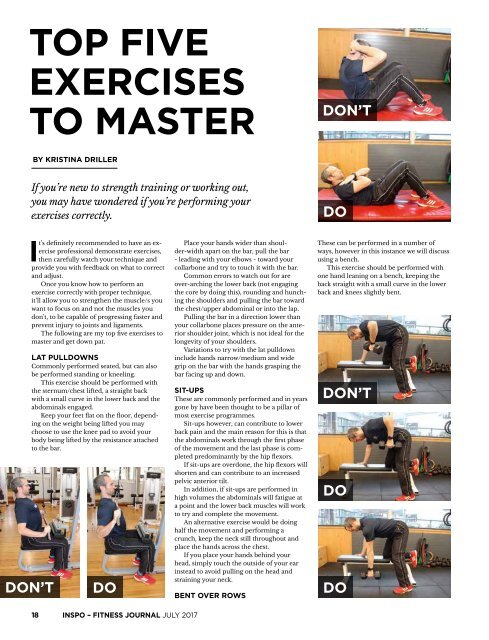INSPO Fitness Journal July 2017
Everything from nutrition, beauty, home and workplace wellbeing to health, performance – and so much more.
Everything from nutrition, beauty, home and workplace wellbeing to health, performance – and so much more.
Create successful ePaper yourself
Turn your PDF publications into a flip-book with our unique Google optimized e-Paper software.
TOP FIVE<br />
EXERCISES<br />
TO MASTER<br />
DON’T<br />
BY KRISTINA DRILLER<br />
If you’re new to strength training or working out,<br />
you may have wondered if you’re performing your<br />
exercises correctly.<br />
DO<br />
It’s definitely recommended to have an exercise<br />
professional demonstrate exercises,<br />
then carefully watch your technique and<br />
provide you with feedback on what to correct<br />
and adjust.<br />
Once you know how to perform an<br />
exercise correctly with proper technique,<br />
it’ll allow you to strengthen the muscle/s you<br />
want to focus on and not the muscles you<br />
don’t, to be capable of progressing faster and<br />
prevent injury to joints and ligaments.<br />
The following are my top five exercises to<br />
master and get down pat.<br />
DON’T<br />
LAT PULLDOWNS<br />
Commonly performed seated, but can also<br />
be performed standing or kneeling.<br />
This exercise should be performed with<br />
the sternum/chest lifted, a straight back<br />
with a small curve in the lower back and the<br />
abdominals engaged.<br />
Keep your feet flat on the floor, depending<br />
on the weight being lifted you may<br />
choose to use the knee pad to avoid your<br />
body being lifted by the resistance attached<br />
to the bar.<br />
DO<br />
Place your hands wider than shoulder-width<br />
apart on the bar, pull the bar<br />
- leading with your elbows - toward your<br />
collarbone and try to touch it with the bar.<br />
Common errors to watch out for are<br />
over-arching the lower back (not engaging<br />
the core by doing this), rounding and hunching<br />
the shoulders and pulling the bar toward<br />
the chest/upper abdominal or into the lap.<br />
Pulling the bar in a direction lower than<br />
your collarbone places pressure on the anterior<br />
shoulder joint, which is not ideal for the<br />
longevity of your shoulders.<br />
Variations to try with the lat pulldown<br />
include hands narrow/medium and wide<br />
grip on the bar with the hands grasping the<br />
bar facing up and down.<br />
SIT-UPS<br />
These are commonly performed and in years<br />
gone by have been thought to be a pillar of<br />
most exercise programmes.<br />
Sit-ups however, can contribute to lower<br />
back pain and the main reason for this is that<br />
the abdominals work through the first phase<br />
of the movement and the last phase is completed<br />
predominantly by the hip flexors.<br />
If sit-ups are overdone, the hip flexors will<br />
shorten and can contribute to an increased<br />
pelvic anterior tilt.<br />
In addition, if sit-ups are performed in<br />
high volumes the abdominals will fatigue at<br />
a point and the lower back muscles will work<br />
to try and complete the movement.<br />
An alternative exercise would be doing<br />
half the movement and performing a<br />
crunch, keep the neck still throughout and<br />
place the hands across the chest.<br />
If you place your hands behind your<br />
head, simply touch the outside of your ear<br />
instead to avoid pulling on the head and<br />
straining your neck.<br />
BENT OVER ROWS<br />
These can be performed in a number of<br />
ways, however in this instance we will discuss<br />
using a bench.<br />
This exercise should be performed with<br />
one hand leaning on a bench, keeping the<br />
back straight with a small curve in the lower<br />
back and knees slightly bent.<br />
DON’T<br />
DO<br />
DO<br />
18 <strong>INSPO</strong> – FITNESS JOURNAL JULY <strong>2017</strong>


















